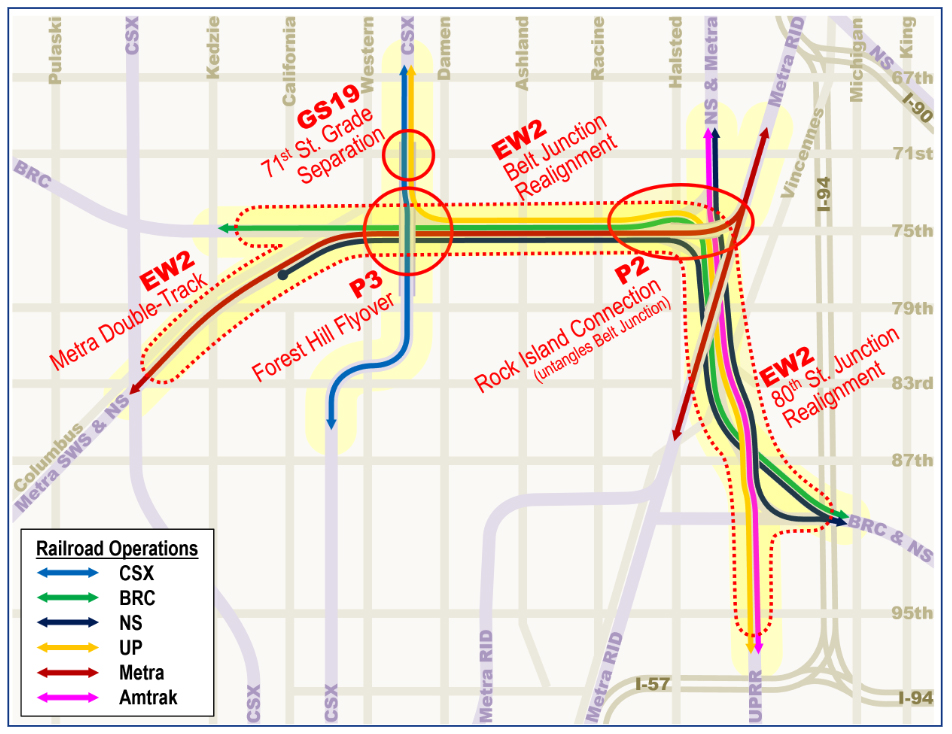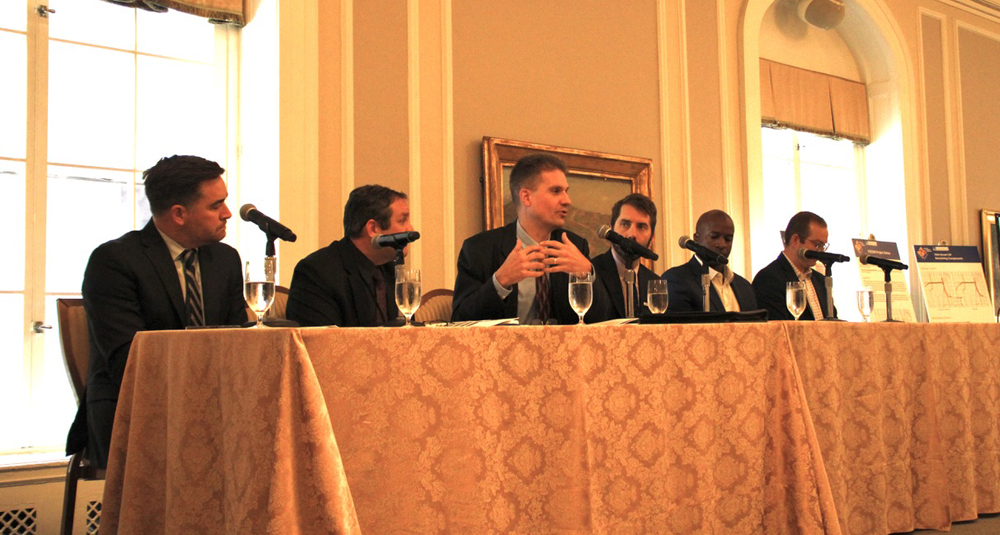
CHICAGO — It’s a measure of how large CREATE’s 75th Street Corridor Improvement Project is that, even having been divided into more manageable parts, it’s still too big, from a financial standpoint, for one of those parts to be fully funded through the federal government’s Mega Grant program.
So, when CREATE — the Chicago Region Environmental and Transportation Efficiency Program, to be formal — decided to pursue a Mega Grant, it had to come up subdivision of the project — a piece of a piece, if you will — that could work from a funding standpoint and meet the various qualifications to give it a chance for selection under the highly competitive big-ticket infrastructure grant program.
In a Wednesday program at the Union League Club, representatives of some of CREATE’s many rail industry and governmental partners essentially made their public sales pitch for their $260 million grant application, explaining the project they had defined for federal funding, and why it not only is the kind of project of national freight and passenger impact that meets the requirements for Mega Grant eligibility, but has significant local benefits as well.
To review the state of the 75th Street project, construction is underway to build a flyover at Forest Hill Junction that will carry the CSX main line over Norfolk Southern, Metra, and Belt Railway of Chicago tracks that the double-track CSX line current crosses at grade, eliminating a huge number of operating conflicts. At the same time, a grade crossing is being eliminated at 71st street. In CREATE’s labeling protocol, this is known as project P3. The next step will take along a 3-mile stretch east of there, with realignments at Belt Junction and 80th Street Junction to further eliminate conflicts between those railroads, as well as Union Pacific and Amtrak. This is CREATE’s project EW2.
Contained with that project is the portion of the work designated for the Mega Grant. It would replace or upgrade a total of 86 viaducts at 14 locations within the boundaries of the EW2 project, addressing structures that range from 110 to 130 years old. Much of this would lay the foundation for the later rail realignments, but it would lead to immediate improvements for the community around the rail lines, said Herbert Smith, Norfolk Southern’s regional vice president, government relations. He was one of six panelists discussing the project.
“We’re going to modernize [the viaducts] to the needs of the current century,” Smith said. “… A decade ago, when we went into the South Side and we had input from the community, they said they did not see the national benefits of the freight rail or intercity passenger rail growth. What they saw were barriers to their community. And we took that to heart. We said, how can we do more for the communities themselves? …
“There are targeted mobility improvements as part of this grant application, which are tangible benefits for the community.” Added Jason Osborn, director of intermodal project implementation at the Illinois Department of Transportation, “What we’re trying to think of as public partners is how … we can front load the public benefits and make sure it’s not like go, ‘The general public will get yours, just way, just keep waiting.’”
By creating such community benefits, the CREATE partners believe they can only help the way their grant application is assessed by federal officials. Jack Eskin, an environmental planner at consulting firm HNTB, explained that key criteria for analyzing the applications include safety, state of good repair, economic impacts, freight movement, job growth, environmental impacts, equity, quality of life, multimodal options, and innovation.
“So we look to really highlight the benefits of this project across all those categories, with the idea that there are certain categories where this project really soars — state of good repair; freight movement, and job benefits. … Safety, our modeling showed that the viaduct improvements that are going to come from this project are going to result in a 30% reduction in crash events, as well as preventing potential closures that would impact Metra Southwest Service, which obviously gets into transportation affordability and equity concerns.
“So it was an opportunity to think comprehensively about how this project is more than just fixing bridges and realigning track.”
Amtrak sought but failed to secure a Mega Grant of more than $250 million last year for a project to improve Chicago Union Station and routes into the city; earlier this year, the passenger operator and its partners said they would seek more than $870 million for that project through a Federal-State Partnership grant [see “Chicago Hub project vies for big chunk of federal grant money,” Trains News Wire,” Aug. 3, 2023]. And the panel was asked if that effort and projects at places like O’Hare and Midway airports might impact federal willingness to provide additional CREATE funding.
“Our experience is that each grant opportunity is in some respects self-contained,” said Jeff Sriver, director of transportation planning at the Chicago Department of Transportation. “They’re looking at the best projects across the country for that particular grant opportunity, so our CREATE projects aren’t competing for funds and things like that. … If we can show that across the country, we’re among the most competitive projects for the grants we’re applying for, then it won’t matter.”
Osborn, though, admitted to a bit more concern: “Sometimes I think with the programs, they do look a little bit at spreading it around the country, for whatever reason. So that is a concern of ours. But we hope that they’ll take our numbers for what they are, and they agree that you can’t go wrong investing here.”
— Updated at Oct. 20 at 4:45 p.m. to correct reference to 75th Street Corridor’s project P3.















Having lived on the south side of Chicago pretty much all my life and having been a railroader that actually worked trains over the tracks involved in the project, I can’t help but wonder why now? For years the Pennsylvania/Penn-Central 59th Street Yard arrival yard crossed 71st Street at grade, as did C&O/Pere/Marquette – literally dozens of trains daily. Further south of the above mentioned area, at about 77th Street, was the Wabash/Belt Railway of Chicago. Again, dozens of moves daily, including all the transfer jobs to Clearing Yard all crossed Southwest Highway at grade. The area just north, 63rd Street and Western Ave area had LOTS of retail businesses, car dealerships and even manufacturing plants. All gone now, so less vehicle traffic. Fewer (yes, longer) trains but I simply don’t see the need, other than make-work jobs and pork.
Just maybe the great reduction in towers all along the tracks with the loss of knowledge and onsite management tower operators had has led to greater train/vehicle conflict.
“The best time to plant a tree was 20 years ago. The second best time is now”